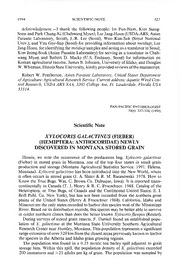
Xylocoris galactinus (Fieber) (Hemiptera: Anthocoridae) newly discovered in Montana stored grain PDF
Preview Xylocoris galactinus (Fieber) (Hemiptera: Anthocoridae) newly discovered in Montana stored grain
1994 SCIENTIFIC NOTE 327 Acknowledgment.— I thank the following people: Im Pun-Nam, Kim Ssang- Soon and Park Chung-Ki (Chahwang Myun), Lee Jang-Hoon (USDA-ARS, Asian Parasite Laboratory, Seoul), J.-R. Lee (Seoul), Woo Kun-Suk (Seoul National Univ.), and Yun Gye-Sup (Seoul) for providing information about metdugr, Lee Jang-Hoon, for identifying the metdugi samples and acting as a translator in Seoul; Kim Jeong-Sook (Asian Parasite Laboratory) for serving as a translator in Chah¬ wang Myun and Robert D. Macke (U.S. Embassy, Seoul) for information on Korean agricultural income. James B. Johnson, University of Idaho, and Douglas W. Whitman, Illinois State University, kindly provided reviews of the manuscript. Robert W. Pemberton, Asian Parasite Laboratory, United States Department of Agriculture-Agricultural Research Service. Current address: Aquatic Weed Con¬ trol Research, USDA ARS SAA, 3205 College Ave, Ft. Lauderdale, Florida USA 33314. PAN-PACIFIC ENTOMOLOGIST 70(4): 327-328, (1994) Scientific Note XYLOCORIS GALACTINUS (FIEBER) (HEMIPTERA: ANTHOCORIDAE) NEWLY DISCOVERED IN MONTANA STORED GRAIN Herein, we note the occurrence of the predaceous bug, Xylocoris galactinus (Fieber) in stored grain in Montana, one of the top four states in small grain production and storage (Montana Agricultural Statistics Service. 1991. Helena, Montana). Xylocoris galactinus has been introduced into the New World, where it often occurs in stored grain (J. A. Slater & R. M. Baranowski. 1978. How to Know the True Bugs. Wm. C. Brown Co. Dubuque, Iowa). It is reported trans- continentally in Canada (T. J. Henry & R. C. Froeschner. 1988. Catalog of the Heteroptera, or True Bugs, of Canada and the Continental United States. E. J. Brill Publ. Co. New York), but has not been recorded from the northern great plains of the United States (Henry & Froeschner 1988). California, Idaho and Missouri are the only states recorded to harbor this species west of the Mississippi River. Based on its distribution records, this species may be better able to survive in colder northern climes than does the better known Xylocoris flavipes (Reuter). During surveys of stored grain insects, F. Dunkel found an established popu¬ lation of X. galactinus at the Montana State University Southern Agricultural Research Center near Huntley, Montana. This population represents a significant range extension of over 320 km from the closest areas previously known to harbor the species in the Alberta and Idaho grain growing regions. The population was found in a 0.25 metric ton barley spill adjacent to grain storage bins. Within this spill, the population density of X. galactinus exceeded 200 immatures and >25 adults per kg of grain. The population was sampled by 328 THE PAN-PACIFIC ENTOMOLOGIST Vol. 70(4) sieving the grain every two weeks through Aug and Sep 1992, and a laboratory culture of X. galactinus was derived therefrom. Other insects found in the spilled grain, and potentially available as food for X. galactinus included: Trogoderma spp. (Dermestidae); grain beetles, Cryptolestes spp. (Silvanidae); hairy fungus bee¬ tles, Typhea stercorea (L.) (Mycetophagidae); picnic beetles, Carpophilus spp. (Nitidulidae); red flour beetles, Tribolium castaneum (Herbst) (Tenebrionidae); and larger black flour beetles, Cynaeus angustus (LeConte) (Tenebrionidae). Because X. galactinus is a beneficial insect exempted from tolerance by the U.S. Environmental Protection Agency and the U.S. Food and Drug Administration (Anonymous. 1992. Federal Register, 57, No. 78, April 22, 1992), it is a possible biocontrol agent for insects destructive to stored grain. Efforts are underway to adapt X. flavipes culture techniques to X. galactinus that may provide a better control option in colder climates. Record.—Montana. YELLOWSTONE CO.: nr Huntley, Aug/Sep 1992, F. Dunkel, ex. barley spill nr storage bins. Acknowledgment.— We thank T. J. Henry, U.S. Department of Agriculture- Systematic Entomology Laboratory, Washington D.C., for confirming the iden¬ tification of X. galactinus. This paper was supported by Montana Agricultural Experiment Station (MAES) Projects 156 (M. Ivie P.I.), 157 and 161 (F. Dunkel P.I.) and is contribution J-2830 of the Montana Agricultural Experiment Station. This is a contribution to Regional Project NC-151 Delivery and Marketing of Quality Grain and Oilseeds. Florence V. Dunkel and Michael A. Ivie, Department of Entomology, Montana State University, Bozeman, Montana 59717. PAN-PACIFIC ENTOMOLOGIST 70(4): 328-330, (1994) Scientific Note DESCRIPTION OF A SLEEPING AGGREGATION OF MALE CHALICODOMA CHILOPSIS (COCKERELL) (HYMENOPTERA: MEGACHILIDAE) The occurrence of male sleeping aggregations is characteristic of many species of aculeate Hymenoptera (Linsley, E. G. 1962. Ann. Entomol. Soc. Amer., 55: 148-164). The majority of these aggregations occur on “sleeping plants,” where the bees grasp a stem with mandibles and/or legs. The bees show a preference for dead or dry, relatively rigid, moderately tall (1 to 2 m), multibanched plants. This behavior has been recorded for many species of bees and wasps, but has been poorly documented for the diverse family Megachilidae. Linsley (1962) recorded two megachilid species (Anthidiellum notatum robertsoni Cockerell and the clep- toparasite Coelioxys deplanata Cresson) as members of larger mixed species sleep-
